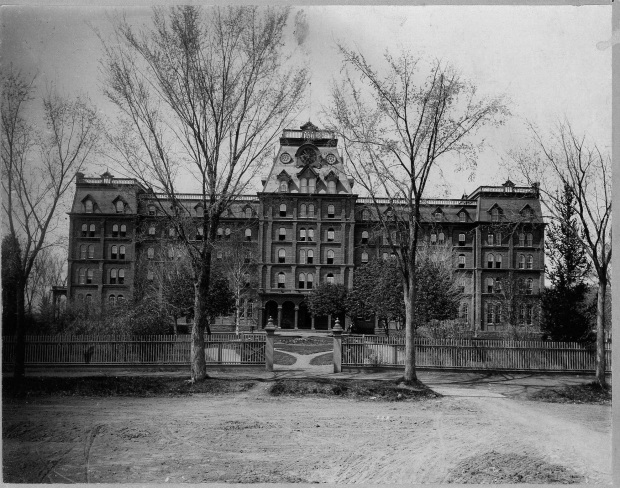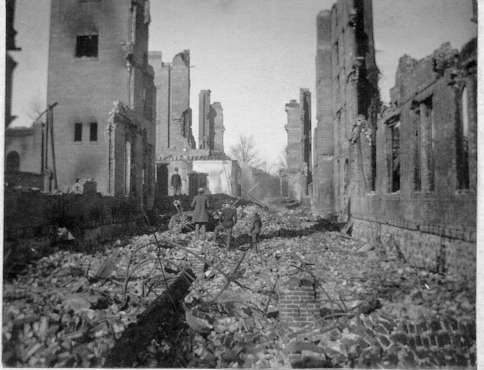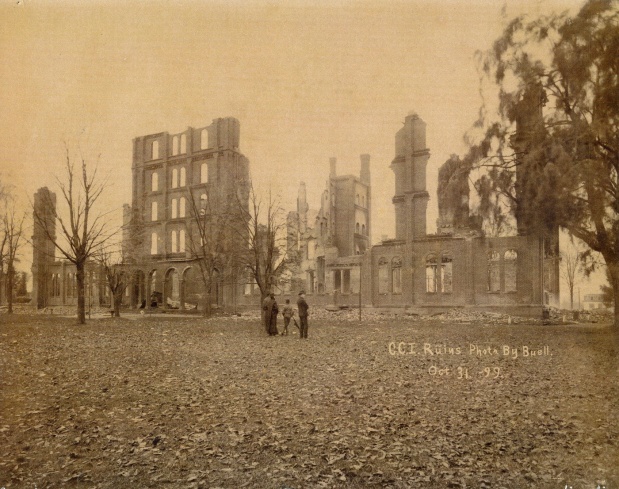The twenty-fifth anniversary of the Centenary Collegiate Institute would prove to be a critical year for the school, testing the dedication and determination of every member of Centenary’s community. Shortly after midnight on the morning of October 31st, 1899, a fire started that demolished the main building, leaving students and staff without dormitories, classrooms, or possessions.
The origin of the fire is unknown, but was attributed to the spontaneous combustion of painters’ supplies stored too close to a boiler room in the basement. A night watchman discovered the fire but was unable to fight the flames by himself. He alerted Mr. Terrill, the College’s bookkeeper, and brother-in-law to current president, Dr. Wilbert P. Ferguson. The two men rushed from Mr. Terrill’s room on the fourth floor back down to the basement, accompanied by three professors who had detected the faint smell of smoke. The men, seeing the basement engulfed in flames, abandoned their idea of putting the fire out themselves, and quickly created a plan for rousing the building’s sleeping occupants. One went to notify the president’s family, another to the teachers in the ladies’ halls, the third to the teachers in the men’s halls, the fourth to the servant’s hall, and the last ran to summon the fire department.
Within minutes all were awake and exiting the building. The ladies were assembled and organized by their heroic preceptress, Mrs. Hoag, and Mrs. Ferguson, the President’s wife. At some point the ladies were sent across campus to the gentlemen’s gymnasium, where Mrs. Hoag called attendance from memory. The professors visited the gentlemen’s halls until they were certain that every young man had escaped. There were no casualties and no serious injuries, save for one young man with weak lungs who suffered minor smoke inhalation.
At 2 a.m. the bell in the clock tower tolled for the last time, falling to the ground after the final chime. By 4 a.m. the destruction was complete. Nothing remained of the building but sections of brick wall. Two gymnasiums, the chemical laboratory, the barn, and the icehouse survived, as they were located across campus. The fire department, town citizens, and C.C.I. students and staff tried valiantly to put out the fire, but the flames traveled through a pipe organ shaft and empty stairwells, consuming the chapel and library. Soon after the whole building was ablaze. Every student, professor, and employee lost some of their possessions, and many lost everything but their bedclothes. That morning the building lay in ruins. Students and staff assembled in the Methodist Church, where they were given permission to go home.
All seemed lost, but the Board of Trustees and President were not willing to give up on Centenary easily. As early as November 7th, announcements were sent out that the school would continue its Fall Term. Classes reopened on November 20th. Local hotels and resorts offered their facilities to the Institute, and C.C.I. gratefully accepted the hospitality of the citizens of Hackettstown. Private homes were turned into dormitories and classrooms. Each home was dubbed a hall, and to tell them apart, each hall was given a professor’s name. The chapels on Main Street offered space for meals and recitation. Life continued at C.C.I. in unfamiliar settings, but it continued nonetheless. A class of forty-three graduated that year.
After the year concluded, the Board of Trustees and Dr. Whitney again began the daunting task of fundraising to rebuild Centenary. A new president, Dr. Charles W. McCormick, was inaugurated, and plans were set in motion to reformat the Institute as a day school until construction could be completed. All other departments were shut down in order to focus on the College Preparatory program. A hall was rented in town for recitations, and students boarded with private families. The day school only had two teachers, Miss Hannah Voorhees and Professor Hammond, who each taught eight classes a day.
Funds were raised to begin the construction of a new Institute, and the cornerstone for the new building was laid on December 1, 1900. The college reopened on September 23, 1901, although the chapel and recitation rooms were still under construction. The new structure was completed before the end of 1901, and Centenary was off and running once again.

The new Centenary Collegiate Institute main building, with dormitories in separate buildings on either side of the school.




